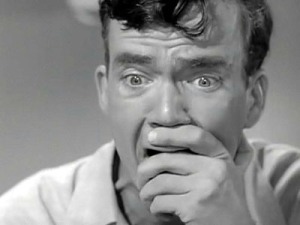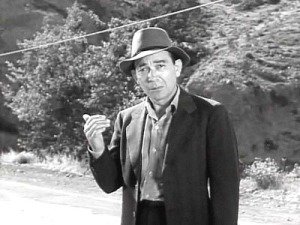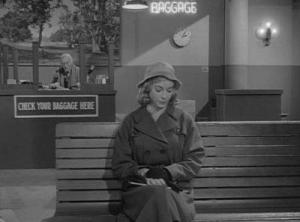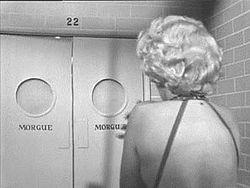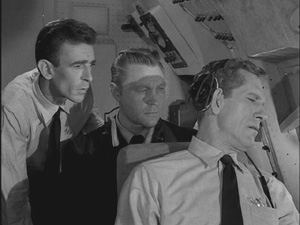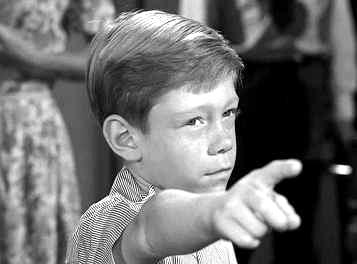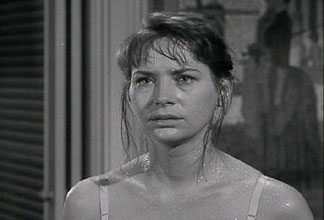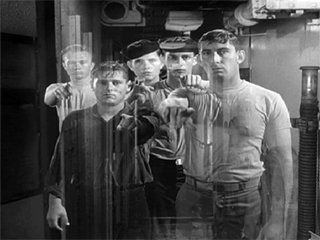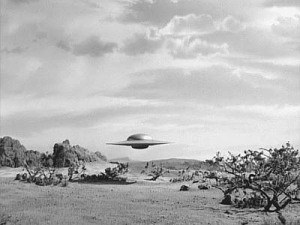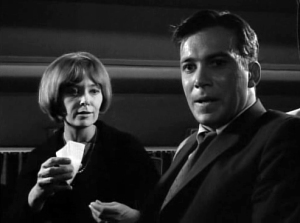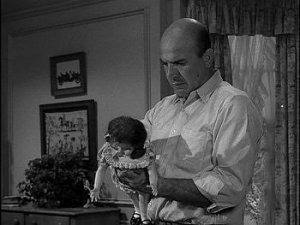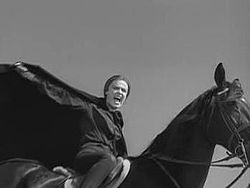Return to The Twilight Zone: 12 Flat-out Freaky episodes
Last July, I wrote a blog post titled “14 Great Twilight Zone ‘Message’ episodes”. To this day, it is my most visited and popular post. Not only did my visitors evidently enjoy reading about the messages inserted into many classic Twilight Zone episodes, I quite enjoyed writing about them. Now, nine months later, I have decided to revisit the Zone. Here are, in my opinion, the greatest Twilight Zone episodes that do what the series was designed to do – unnerve, unsettle, and quite simply try to scare the ever-loving crap out of the viewer.
(Although many of the “Message” episodes I wrote about in my previous post were also freaky, I’m leaving them out to prevent repeats. I will apologize in advance and warn that this post will likely be very long, but I hope that the journey is worth the time. Here are my picks, in order of appearance … But first, something to get you in the proper frame of mind…)
————————————————————
1. And When the Sky Was Opened (Season 1, Episode 11)
Freak-out Factors: Unexplained disappearances, mass amnesia
I’m starting the list out with one of the greatest and most terrifying TZ episodes ever and, strangely, one that is often overlooked. The episode starts out with three astronauts – Gart, Forbes, and Harrington – flying a prototype spaceship known as the X-20 on its first test flight. Inexplicably, the ship soon disappears from radar for no apparent reason. After trying in vain to reach the astronauts for a full 24 hours, the controllers on the ground are both relieved and puzzled when the ship reappears on radar and crashlands in the Mojave desert. The three men survive and, besides Gart suffering a broken leg, are no worse for wear.
However, soon after the astronauts’ return to Earth, it quickly becomes apparent that not is all as it seems. While Gart lies in the hospital recovering from his leg injury, Forbes and Harrington go to a nearby bar. There, Harrington starts feeling and acting very oddly, frightening Forbes with strange comments that imply that they no longer “belong”. Seized with panic, Harrington rushes to a pay phone to call his parents, only to find out that they do not know him and claim to not have a son. Suddenly, Harrington disappears. Horrorstruck, Forbes asks the other bar patrons if they saw what he had just seen, only to receive suspicious looks and patronizing answers – everyone swears that Forbes had entered the bar alone. Nobody has any recollection of Harrington ever existing, except Forbes. In a panic, Forbes leaves the bar and heads towards the hospital, but not before catching a glimpse of that day’s newspaper. No longer does the headline claim that three men made it back safe from the X-20’s crash landing; now it reads that two men were on board.
Rushing to the hospital, Forbes confronts Gart and tells him of Harrington’s disappearance. Gart tells him that he knows of no man named Harrington and insists that only himself and Forbes were in the spaceship. Upon hearing this, Forbes’ mind finally snaps and he runs screaming out of the room. Limping after him on his broken leg, Gart tries to stop him but discovers that Forbes has now disappeared. Nobody at the hospital remembers Forbes and the newspaper on Gart’s hospital bed no longer reads “Two men”, but rather “Lone Man”. Everybody now believes Gart to have been the sole astronaut. As the reality of the situation dawns on Gart, he too disappears. Even the recovered wreckage of the X-20 is wiped off the face of the Earth. The X-20’s doomed flight is forgotten by everyone, as if it had never happened.
A classic TZ episode, And the Sky Was Opened creepily implies that the astronauts aboard somehow cheated death and were not supposed to have survived the crash, so Death corrected its mistake by erasing them from existence altogether. Uneasy viewers are left to wonder what exactly happened in the 24 hours that the astronauts were missing from radar.
————————————————————
2. The Hitch-Hiker (Season 1, Episode 16)
Freak-out Factors: Mysterious stranger, unexplainable paradox
The Hitch-Hiker is one of the better-known episodes, and for good reason. The episode begins with a lone woman, Nan Adams, driving cross-country from New York to Los Angeles. After her car has a flat tire in Pennsylvania, a mechanic fits it with a spare and leads her to the nearest town to fix it properly. While waiting at the service station, Nan notices a hitchhiker standing at the nearby highway looking for a lift. Her car is quickly repaired and Nan sees that the hitchhiker has yet to have found a ride. Nan drives past him and notices that he seems to be closely watching her, but she thinks little of it. A couple hours down the road, Nan is surprised to see the man standing on the side of the road, still thumbing for a ride and watching her as she drives past. Nervous, Nan attempts to come to a conclusion as to how the man could have ended up ahead of her on the road, but can think of nothing. Soon after, she rounds a bend and sees him again – with the same placid look on his face, thumb out, watching her drive past.
The nightmare continues. Hour after hour, Nan drives past the hitchhiker again and again, the man always somehow staying ahead of her on the road when such a feat is clearly impossible. Later, Nan’s car stalls on a set of railroad tracks and she barely manages to get it started and drive off before an incoming train would have crushed her. Throughout the terrifying event, the hitchhiker is standing mere feet away, watching Nan the entire time. Convinced that the man is trying to kill her, Nan presses on, hoping that if she can just make it to L.A., that will somehow bring her ordeal to an end. Unfortunately, her car breaks down once again in New Mexico.
After more repairs, and on the lookout for the hitchhiker, Nan instead meets a sailor on leave needing to get back to his ship at San Diego. She convinces him to ride along, hoping that the hitchhiker will abandon his hunt if she is not alone. The ruse doesn’t work, however, and Nan sees the man again, in the same pose as always. This time, she attempts to run him down and nearly crashes the car. The sailor, frightened for his own safety, leaves Nan alone again, but not before horrifying Nan by telling her that he hadn’t seen any man on the side of the road at all.
Now in Arizona, Nan stops at another service station to call her mother, but her mother doesn’t pick up. Her mother’s friend does instead, telling Nan that “Mrs. Adams” is in the hospital. She suffered a nervous breakdown after she learned that her daughter had died in an auto accident in Pennsylvania a week earlier. And so Nan learns the truth. The flat tire in Pennsylvania at the beginning of the episode had been much more. The accident had killed Nan and the hitchhiker that she saw from that point on was Death, waiting for Nan to realize that she had died so she could pick him up. Nan numbly hangs up and walks back to her car. Upon entering, she looks in the rearview mirror and the hitchhiker is sitting in the back seat, smiling pleasantly. As the episode ends, the man says “I believe you are going….my way?”
The Hitch-Hiker deftly plays on that ancient fear of death, as well as the fear of the impossible somehow becoming possible. There is no possible way that the man could constantly stay ahead of Nan on the road, but there he is time and time again, a situation that could have easily caused Nan to wonder if she was going insane…if she hadn’t already been dead.
————————————————————
3. Mirror Image (Season 1, Episode 21)
Freak-out Factors: Mysterious stranger, alien invasion, unaware secondary characters
Mirror Image is another episode in which only the main character perceives frightening events in a certain situation, with part of the terror coming from secondary characters having no idea of what’s happening all around them. The episode begins with a young woman named Millicent waiting for a bus at a bus station. Nothing seems out of the ordinary until she notices from looking at a wall clock that her bus is running late. She walks up to the ticket counter and asks the man if he knows when the bus will be arriving. Exasperated, the man tells her that is the third time she has asked him and he still doesn’t know. Puzzled, she denies this, but the man irritably insists that she has asked him multiple times about her bus’ arrival. She leaves her bag on the bench to ask the man at the luggage counter if he knows when the bus will arrive, only to notice a bag that looks like hers in the pile next to his desk. She looks back at the bench and her bag is gone.
Shaken, Millicent enters the bathroom to freshen up, only for the attendant to remark that she had just used the bathroom, regardless of Millicent’s insistence that she had not. While leaving the restroom, she is stunned to notice a woman who looks exactly like her in the mirror’s reflection sitting on a bench outside. By the time she can get a closer look, the woman is gone. Millicent strikes up a conversation with a man, Paul, who is also waiting for a bus. To calm her nerves, Millicent confides in Paul about the strange woman. He tries to ease her mind by assuring that it’s just a coincidence or her imagination but, when Millicent’s bus arrives, she is shocked to see the woman already sitting aboard the bus. She looks exactly like Millicent and stares at her with a look of malicious humor. Millicent runs back into the depot and faints.
Paul purposely misses his bus to attend to Millicent. When she awakes, she tells him what she saw and says that she understands what is happening, as she had read about it in a science fiction periodical. She insists that the woman is her double from a parallel universe, an evil doppelganger, who was able to invade the world through unknown means. Millicent also claims that the woman means to kill her, as that is the only way that the doppelganger can stay on this plane of existence. Taken aback, Paul continues to try to soothe Millicent and worries that she may be going insane. Without her knowledge, Paul calls the police to come take Millicent away and get her psychiatric help. Two policemen arrive and escort Millicent out of the bus depot while she pleads with Paul to believe her.
Settling himself after the bizarre encounter, Paul walks to the nearby drinking fountain for some water. When he turns around, he is surprised to see his briefcase missing from the bench and a man running out of the bus station with it. Paul chases the man down the street until the man suddenly stops and turns around. Terrified, Paul realizes that he is chasing an exact copy of himself, but the double’s face is twisted and evil. With a laugh, the doppelganger once again runs down the street while Paul can only watch, dumbfounded, his sanity beginning to crumble.
Mirror Image plays on the paranoid fear of seeing the world differently than everyone else. This particular episode takes that to the extreme to the point that only Millicent becomes dimly aware of an invasion of evil into the world, while everyone else is blissfully unaware until it is too late.
————————————————————
4. Twenty Two (Season 2, Episode 51)
Freak-out Factors: Premonitions, nightmares, impending doom
Liz Powell, a stripper, has suffered a nervous breakdown and been flown to an out-of-state hospital to recuperate. The recovery is going reasonably well, but there is a problem. Every night, Liz has the same nightmare… it’s midnight; she rises from her hospital bed and knocks a glass of water off of the table (breaking it). Then she hears footsteps outside of the door and the door opens. A nurse appears in the doorway and beckons Liz to follow her. She follows the strange woman to an elevator and is taken to another floor. When she leaves the elevator, the woman is gone, but a lone door appears at the end of a hallway – Room #22. Suddenly, the woman emerges from the shadows and smiles evilly at Liz, saying “room for one more, honey”. At this point, Liz screams, runs back down the hallway…and awakens from the dream. Every night, Liz awakens in terror after experiencing the same oft-putting nightmare.
After the nightmare begins to interfere with her recovery, Liz asks her doctor what she can do to break the cycle. The doctor is initially puzzled – the woman that torments Liz in her dream seems to fit the description of a nurse, but when she is asked to describe the woman’s face and appearance, her description matches none of the nurses who work at the hospital. The doctor is unsure where Liz would have seen her before. He suggests that she attempt to change her behavior in her dream to hopefully alter its outcome. That night, Liz has the same dream but purposely does not reach for the glass of water when she rises from the bed. Instead, she lies back down, but upon doing so, her blanket knocks the glass off of the table and the dream progresses from there as it always has. This time, though, Liz sees something during the dream that she never has before: the inside of Room #22. It is a morgue.
The next morning and with growing fright, Liz describes the previous night’s dream to her doctor. He is shocked as Liz somehow describes the hospital’s real morgue with uncanny accuracy, even though she has never been there. As Liz has generally recovered from her prior nervous breakdown, however, he discharges her from the hospital, partially in the hopes that when she leaves, her nightmares will cease.
As she arrives at the airport to fly back home, Liz becomes nervous when she notices that her plane is designated as Flight #22. While getting in line to embark, she accidentally bumps into a woman holding a vase, causing her to drop it. The breaking vase sounds exactly like the breaking glass in Liz’s dream. Now barely clinging to sanity, Liz slowly walks up the runway to the awaiting flight and shakily climbs the stairs to the door, only to be confronted by a stewardess who is the “nurse” from her dream. The stewardess smiles and says “room for one more, honey.”
Shrieking in terror, Liz bolts back down the stairs and across the tarmac back to the terminal before collapsing in hysterics. Airport staff rush to calm her as Flight #22 pulls away from the terminal, taxis down the runway and finally takes off…exploding in a ball of flame seconds later.
This episode is particularly creepy, as Liz’s nightmare acts as precognition for her doomed flight back home. Without the recurring nightmare and the fear that accompanied it, Liz would have been killed in the the explosion. Instead, it saved her life.
———————————————————–
5. The Odyssey of Flight 33
Freak-out Factors: Supernatural forces, time travel
Flight 33 is a Boeing 707 flying from London to New York City. The year is 1961, the flight is routine, the crew is well-trained, and nothing, at least initially, appears amiss. The normal flight is suddenly thrown for a loop, however, about an hour into the flight, when the captain realizes that the jet has begun gaining substantial speed for no reason. The flight crew feverishly searches for a reason to this enigma while the plane eventually reaches speeds never before attained, before breaking through some kind of barrier with a flash of light.
After regaining their senses, the crew checks the instruments to find that the Boeing is again flying at normal speed, but has already reached the American mainland, a feat that is realistically impossible. Hoping to quickly land the plane to analyze what went wrong, the flight crew flies to LaGuardia Airport. Instead of finding New York City, however, the crew sees nothing but swampland and jungle. In shock, the crew and passengers alike look out the windows to see an enormous Brontosaurus grazing far below. While the passengers begin to panic and ask for answers, the crew tries to understand what has happened. They soon realize that somehow the plane got caught up in a temporal “current” of some kind and got swept back in time. Obviously not knowing how to get back home, the crew decides that their best alternative is to reverse course and hope to ride the current back to their own time.
The pilot turns the plane around and, just as the crew hoped, the plane soon begins to wildly accelerate. The flash of light repeats itself and the plane slows, as the hopeful crew turns the plane back towards New York. As the mainland comes into view, the flight crew joyfully sees buildings and familiar landmarks, believing they have made it back to the present. Their happiness turns to dismay, though, when they realize that they have actually appeared over New York City during the 1939 World’s Fair. They have not made it “all the way” home, but rather 22 years too early. The airports in 1939 are not advanced enough to allow a Boeing 707 to land so, with no other options available, the flight crew again turns the jet around to try flying through the time current again. The episode ends with the jet running low on fuel and the pilot nervously asking the passengers to all pray for their safe return.
A great TZ episode that eschewed a happy ending, The Odyssey of Flight 33 was given just a bit more freakiness by Rod Serling’s ending monologue. In it, he mentioned the people back in 1961 who were searching for Flight 33 and would never find it. But he added that if you heard strange, sputtering, distressed engines above you during an overcast night, it might just be Flight 33 “trying to get home”. Yikes.
———————————————————–
6. It’s a Good Life (Season 3, Episode 73)
Freak-out Factors: Two words – Anthony Fremont
Among the majority of Twilight Zone fans, It’s a Good Life invariably ends up near the top of favorite episode lists. And that is because of the performance of Billy Mumy, who plays the sociopathic and downright evil main character. No space aliens here. No mysterious and unknowable force behind it all. One of the greatest Twilight Zone villains of all time, Anthony Fremont holds an entire town in his iron grip…and he’s 6 years old.
Peaksville appears on the surface to be a regular Small Town U.S.A. But looks are deceiving. The entire town is in mortal fear of Anthony, who is quite simply a monster in a little boy’s body. Anthony has cut off the town from the outside world – nobody can enter, nobody can leave. He has destroyed that which he dislikes, including automobiles. The televisions play programs which he likes and nothing else. The grocery store only sells food that he likes. And nothing ever occurs in Peaksville that is against Anthony’s wishes. Any resident that disobeys Anthony in any way is never seen again, as Anthony sends them away (in one of the more chillingly vague lines in television history) “to the cornfield”.
The adults are helpless against Anthony’s terrible power and constantly tell him how good he is, regardless of what he does. Early in the episode, a nearby dog begins barking, annoying Anthony. After warning what he will do if somebody does not quiet the dog, Anthony haughtily announces that the dog is “bad”, concentrates, and the dog abruptly stops barking. Even while knowing that Anthony has “disposed” of the dog, his father nervously tells him that he had done “a good thing”.
The incredible strain on the rest of Peaksville finally comes to a head during Dan Hollis’ birthday party, a party that is anything but happy and mirthful. After drinking to muster up some courage, Dan finally confronts Anthony, directly calling him a murderer and unleashing a torrent of rage against the little boy. Anthony becomes angrier and angrier while listening to Dan’s drunken rant and begins to advance on him. Still angry but now frightened, Dan pleads with the rest of the adults to kill Anthony from behind while he is focused on Dan, but the cowed adults cannot. Finally, Anthony interrupts Dan, calling him “a very bad man”. With his power, Anthony first transforms Dan into a huge jack-in-the-box, causing Dan’s wife to shriek in horror. And then, after proving his point, Anthony sends Dan to the “cornfield”, never to be seen again.
Annoyed at the outburst, Anthony causes a sudden snowstorm to spring into existence. The adults anxiously look at each other, knowing the storm’s eventual effects. It is too late in the Spring for a usual snowstorm. This one will kill half of the town’s crops, the adults’ only source for food thanks to Anthony’s blockade of the town. Even with this knowledge, the adults worriedly smile at Anthony, telling him how the snowstorm is “a real good thing”.
Ever the brilliant writer, Rod Serling created a landmark episode with It’s a Good Life. Six-year-old Anthony Fremont is the ruler of an absolute dictatorship, with dozens of big, strong adults completely powerless to stop his each and every whim. Anthony’s hold over Peaksville is so great that even when Dan Hollis sacrifices himself to stop the little boy, nobody in town has the courage to kill Anthony and end his reign of terror. Just imagine having to fulfill any crazy wish that a six-year-old comes up with or be snuffed out and then you can imagine the terror of this episode.
————————————————————
7. The Midnight Sun (Season 3, Episode 75)
Freak-out Factors: Helplessness, natural disaster, end of the world
Contrary to the villain in human form of It’s a Good Life, The Midnight Sun deals with an unfortunate quirk of cosmic fate. Something has happened to the Earth’s solar orbit and the planet and all of its inhabitants end up on a collision course with the sun. As the weeks go by, the temperature increases and increases until people begin dying from the unbearable heat. The sun grows larger in the sky and the dwindling populations move to the polar regions in a futile attempt to escape the inevitable.
In a certain apartment building, everyone has moved out except the landlady, Mrs. Bronson, and an artist, Norma. They keep each other company while watching news reports of food and water shortages, electricity blackouts, looting, rioting, and death. As the days go by, the women visibly perspire as they desperately try to keep themselves cool. A man breaks into their apartment looking for water and, even though Norma has a gun and threatens him with it, she cannot deny him water and allows him to drink a portion of their supply.
Shortly thereafter, the older and weaker Mrs. Bronson finally succumbs to the heat and dies. The temperature climbs to over 120 degrees, melting the paint on Norma’s canvasses. With no way to avoid the sun’s heat, Norma finally screams and falls to the floor, dying of heat stroke.
Suddenly, the scene changes to that of bitter cold and winter. The same thermometer that had earlier been shown climbing above 120 degrees now reads -10. Norma awakens in her bed, after suffering from a serious fever, and is being attended to by Mrs. Bronson and a doctor. During her sickness, Norma dreamed that the Earth had been heading towards the sun. In reality, the Earth’s orbit has shifted, but is actually hurtling away from the sun. Norma’s fevered dreams had led her to cling to a nightmarish world of unbearable heat and light. Norma groggily tells Mrs. Bronson about her terrifying dream and adds how wonderful she thinks it is to be in the real world and its darkness and coolness. Shivering in the frigid cold and watching the world die around her, Mrs. Bronson sarcastically and dreadfully agrees that it is, indeed, “wonderful”.
The Midnight Sun plays upon one of those fears that are beyond our control – that of disaster on a globalwide scale. The entire story has the pall of certain death over it, even as the characters pretend to normally go about their lives as best they can, until it becomes impossible. Of course, the obligatory Twilight Zone twist strikes down the entire heat wave storyline while creating an opposite, but equally as doomed, end of the world.
———————————————————–
8. The Thirty-Fathom Grave (Season 4, Episode 104)
Freak-out Factors: Unexplained phenomena, ghosts, insanity
A United States Navy destroyer is on a routine patrol mission during the 1960s near Guadalcanal when sonar picks up what appears to be metallic clanging sounds coming from the ocean floor. The ship’s captain orders the crew to take a closer look and to pinpoint the sounds’ origin. Upon learning of the sonar reports, Bell (the deck Chief) becomes uncharacteristically disturbed and worried, actually fainting at one point during a related discussion. The destroyer settles above the location and a diver is sent below to investigate. When the diver resurfaces, he reports that the noises are coming from an American submarine that had been torpedoed and sunk 20 years ago, during World War II. He also reports, to the disbelief of the crew, that the sounds are definitely coming from inside the submarine and are similar to those made by striking the hull with a hammer.
The discovery of the wreck, and subsequent joking by members of the crew that the submarine might be haunted, has an even worse effect on Chief Bell. Soon after, it is revealed why – Bell had actually been on board the submarine when it was struck by a Japanese torpedo and sunk during WWII. He managed to escape the disaster, but had been the only survivor. Now being confronted by both the wreck and mysterious noises, Bell is assailed with guilt and slips into dementia. In the infirmary, he has a vision of his dead crewmates as ghosts, soaking wet and reaching for him. Racing away in a panic, Bell hurls himself into the sea and drowns.
After Bell’s death, the captain sends the diver down a second time to see if there is any further information to gather from the wreck before the destroyer resumes its patrol. This time, the diver finds a break in the hull and enters the sub. Inside, he finds a chunk of hanging metal that bangs against the hull whenever the sub shifts due to ocean currents. Satisfied that this is the source of the noises, the curious diver decides to quickly look for the crew before leaving. He soon stumbles upon the eight crewman, all apparently long-dead…one of whom is holding a hammer.
My first Twilight Zone list back in July included a synopsis for the episode King Nine Will Not Return, which also dealt with the specter of survivor’s guilt and the serious forms it can take. The Thirty-Fathom Grave takes a more supernatural and frightening path, while eerily leaving unanswered the real origin of the mysterious noises from the deep.
————————————————————
9. Death Ship (Season 4, Episode 108)
Freak-out Factors: Supernatural forces, unexplained deaths, time loop
To me, Death Ship contains possibly the scariest premise in Twilight Zone history. As a bonus, it features the excellent Jack Klugman, star of The Odd Couple as well as several other Twilight Zone episodes. TZ fans can argue over which Klugman episode was their favorite, but as far as I’m concerned, this is the hands-down freakiest.
Death Ship begins with three men aboard the scout ship E-89 in orbit around a strange planet. The episode is set well into the future, when Earth’s serious overpopulation has led the world governments to send out ships to the far reaches of the galaxy, looking for new worlds to inhabit. This particular ship is crewed by Captain Ross (Klugman) and Lieutenants Mason and Carter. Their mission has been uneventful thus far as the ship flies into the atmosphere and streaks across the landscape. Ordered to collect mineral and plant samples and check for alien life, the crew scans the area and is surprised to see a glint of light off in the distance. Mason and Carter guess that it could be a sign of life, but Ross disagrees, ever cautious. However, he agrees to check out the strange object.
Upon arriving at the glint, the crew is surprised to discover that the source of the glint is a crashed spaceship – one that looks exactly like the ship they are piloting. The crew lands and Mason and Carter insist that they take a closer look. Ross opines that they should leave, but goes along with his crewmen as they approach the wrecked ship. It is indeed an E-89 scout ship and, when they enter, the crew discovers three lifeless bodies inside – their own bodies. As Mason and Carter stare in horror, Captain Ross becomes furious, desperately trying to solve this new paradox. He guesses that somehow time has become warped on this planet, showing the men a glimpse into their future. Finally, he comes up with a plan: the men died when their ship crashed; if they stay on the ground, they cannot crash, and therefore will live. Mason and Carter agree, even as they are visibly becoming more and more disoriented from fear.
Suddenly, Lt. Carter has an hallucination. He is on a peaceful country road by his home back on Earth, seeing people from his past who are long since dead. Carter becomes frightened and runs to the house, hoping to see his wife and children and hopefully put an end to the vision. Instead, the house is deserted. Walking to the kitchen table, he sees a note, picks it up, and reads it. The note is addressed to Carter’s wife, Mary, wishing her condolences regarding the death of her husband.
Carter is wrenched back to the real world by Captain Ross, who tells him that he and Mason also just experienced bizarre hallucinations of their own. In his confused state, Carter strikes Ross but is eventually calmed down by the captain. Ross announces that he believes that he knows what is happening – a secret alien race inhabits the planet and uses telekinetic powers to keep visitors and strangers away. Now Ross believes that they must leave the planet after all; escaping orbit will break the telekinetic spell over the crew and they will be safe. Mason and Carter are terrified, pointing out that taking off in the ship might lead to the inevitable crash, but Ross is not to be swayed.
Much to the lieutenants’ surprise, they successfully leave the planet and settle into a normal orbit without meeting disaster. They are relieved to be able to put the planet far behind them, but are stunned when Ross announces that they will return to the planet to carry out the original orders of sample retrieval. After all, he says, now that they know what they are dealing with, there is nothing to fear. Shocked but numbly following orders, Mason and Carter pilot the ship back down to the planet’s surface. The wreck is still there. Nothing has changed. Terrified, Mason tells the others that he believes they are dead, that it is their dead bodies in the wreck below and they are doomed to travel the planet as ghosts. Carter agrees, but Ross’ rational will is too strong to be broken. He stubbornly and angrily tells his two subordinates that they will go over the problem again and again until they solve it. At the very end of the episode, the ship is once again shown streaking across the planet’s surface, with Mason claiming to see a glint in the distance and Ross urging caution.
As a science fiction fan, this episode particularly resonated with me. Imagine visiting a strange and unknown world, only to stumble upon your own lifeless body and find that you are somehow trapped in an endless loop of terror. I’ll admit that this episode freaked me out and Rod Serling’s ending monologue was particularly awesome —
Picture of a man who will not see anything he does not choose to see — including his own death. A man of such indomitable will, that even the two men beneath his command are not allowed to see the truth; which truth is, that they are no longer among the living, that the movements they make and the words they speak have all been made and spoken countless times before–and will be made and spoken countless times again, perhaps even unto eternity. Picture of a latter-day Flying Dutchman, sailing into the Twilight Zone.
————————————————————
10. Nightmare at 20,000 Feet (Season 5, Episode 123)
Freak-out Factors: Hallucinations, impending doom, unaware secondary characters
Say what you will about William Shatner’s oft-hammy acting, Nightmare at 20,000 Feet is a genuinely frightening story and one of the most popular episodes ever. As a usually-delighted fan of The Shat’s over-the-top hysterics, I personally find this episode to be one of the greatest ever.
Shatner plays Robert Wilson, a salesman who suffered a nervous breakdown six months ago. After several months of recovery, Wilson has returned to his sales career and boards a flight for a faraway sales call for the first time since his breakdown. Accompanied by his wife, Wilson is shy and a trifle nervous, but is friendly to the attendants and fellow passengers and the plane takes off without incident. The night is stormy and overcast and, as rain patters against his window, Wilson settles in his seat on the wing and attempts to relax. Unfortunately, he takes a peek out of his window moments later and sees something that makes his blood run cold – a monster is clinging to the wing of the plane.
A man-sized “gremlin”, the monster sees Wilson staring at him and seems to take delight in his one-man audience. It laughs at Wilson and starts examining the wing, as if deciding how to dismantle it. Frightened, Wilson is unsure what to do, trying to appear calm so that his wife won’t notice his fear. He makes a few offhanded comments regarding the view outside, but every time someone else looks out the window, the gremlin somehow slips underneath the wing and out of sight.
As this happens time and time again, Wilson clearly begins losing his grip on sanity and the other passengers begin noticing something strange with the man, as does his wife. Wilson gamely tries to assure them that it’s just a touch of nerves, shakily wiping his sweating brow with a handkerchief. However, every time he glances outside his window, the gremlin is there. Wilson vainly continues to fight off probing questions from his wife, afraid of a return trip to the sanitarium.
At this point, the gremlin begins tearing panels off of the wing and pulling wires out of their housings. Panicked, Wilson struggles over whether or not to again alert the plane’s crew, who see nothing amiss. He tries to stop himself from looking out of the window, in hopes that it is all an hallucination or a side-effect from his recent nervous breakdown. In response, the monster shambles up the wing and stands right outside of Wilson’s window, staring at him in mockery. the gremlin then turns and crawls back to the end of the wing, clawing at the plane’s nacelles.
At this sight, Wilson finally snaps. Surreptitiously stealing a sleeping policeman’s revolver, Wilson walks up the aisle to the exit door and opens it, causing havoc in the cabin. Despite nearly being blown out of the plane, Wilson takes aim at the monster and shoots it, causing it to tumble off of the wing and become lost in the storm clouds. In the ensuing chaos, several passengers restrain Wilson while others shut the exit door. Soon after, the plane makes a safe landing. Wilson, still gibbering about the monster on the wing, is taken off the plane in a straitjacket while everyone believes him to have been a dangerous lunatic. However, as the episode ends, the camera pans above the chaotic scene to show something that no one has yet spotted – one of the plane’s nacelles, which appears to have been heavily damaged by something with huge claws.
Even though many viewers are often taken out of the frightening aspect of this episode because of the star power of William Shatner and the admittedly cheesy-looking gremlin, Nightmare at 20,000 Feet deals with a very common fear in this age of frequent travel – something going wrong while you’re trapped on a plane. Not content with writing about a simple plane crash, Serling took this story a step further by placing a real and malignant force of evil on the jet, one that may have crippled the plane and killed everyone aboard if not for the heroism of the one man that could see him.
———————————————————–
11. Living Doll (Season 5, Episode 126)
Freak-out Factors: Long before Chucky, there was another devil in doll’s shape – Talky Tina
Living Doll opens with a little girl named Christie and her mother, Annabelle, driving home from the store. Christie is happily playing with a new doll that her mother bought her for her birthday. Upon arriving home, Annabelle warns Christie to take the doll upstairs right away and not show it to her father, but the two are immediately greeted at the door by Annabelle’s husband, Erich. Christie shows Erich the doll, which says “My name is Talky Tina and I love you very much” when Christie turns the key on its back. Oblivious to the child’s happiness, Erich angrily asks how much the doll cost and calls it a waste of money, saying that Christie already has enough dolls. Christie begins to cry, leaves Talky Tina on a table, and runs upstairs.
Annabelle follows Christie upstairs to comfort her and Erich walks to the table to examine the doll. He idly turns the key and is surprised to hear the doll say “my name is Talky Tina and I don’t think I like you”. Puzzled, Erich turns the key again, only to hear the message change again – “my name is Talky Tina and I think I could even hate you”. Erich angrily throws the doll against the wall and walks away.
Soon after, the viewer learns the reason behind the family’s tension. Erich is not Christie’s real father, but rather, her stepfather. He is bitter due to an inability to father children and believes Annabelle resents him for it, as Christie is her daughter from a previous marriage. Annabelle denies this and begs him to be kinder to Christie. Later, at dinner, Christie pretends to feed Talky Tina, which annoys Erich. He irritably accuses Annabelle of buying the doll to purposely mock his sterility. When the other two are eating distractedly, Talky Tina winks at Erich. After dinner, he is again left alone with Talky Tina. This time, it speaks on its own, saying “my name is Talky Tina and I’m beginning to hate you”. Erich replies “my name is Erich Streator and I’m going to get rid of you”. Smirking, Erich places a match next to the doll, implying that he means to burn it, which only leads to further threats from the doll. Erich accuses it of containing a walkie-talkie that Annabelle placed inside to “get back at him”. Talky Tina denies it.
Fed up, Erich takes the doll and throws it inside a garbage can in the garage. When Christie asks him if he knows where it is, Erich says he doesn’t. Moments later, the phone rings and Erich answers it. The voice on the other end says “my name is Talky Tina and I’m going to kill you”. Erich runs to the garage and finds the garbage can empty and Talky Tina nowhere to be found. He accuses Annabelle of conspiring with her daughter to hide the doll from him, to which Annabelle reacts with bafflement, not knowing what he’s talking about. Erich walks into Christie’s room and there Talky Tina sits, next to a fast-asleep Christie on her bed.
Seeing Erich enter the room, the doll speaks to wake Christie up, but Erich snatches the doll from her grip, accusing her of disobeying him. The fight escalates to such a point that when Christie cries “please don’t, Daddy”, Erich shouts in reply “I’m not your Daddy!” Suddenly, it occurs to Erich that neither Annabelle or Christie sound anything like Talky Tina and that the doll must be genuinely acting on its own. The doll is not a trick or a toy – it is possessed.
Now realizing that he must destroy the doll, Erich takes Talky Tina back to the garage, but after using a vice grip, blowtorch, and table saw on the doll, he is unable to damage it in the slightest. Realizing that he cannot destroy it, Erich places the doll in a burlap sack, ties it tightly, and throws it back in the garbage can. He then piles bricks on top of the can and goes back inside to find Annabelle furiously packing her bags. The two violently argue, Annabelle convinced that Erich hates her and Christie and is going insane due to that hatred. Erich fervently apologizes and offers to return the doll to Christie if they stay. Annabelle reluctantly agrees and Erich goes back to the garage to retrieve Talky Tina. Relieved, he finds that the doll is still where he left it, but when Erich removes it from the sack, Talky Tina says “my name is Talky Tina and I do not forgive you”.
That night, Erich hears strange noises outside the bedroom door. Slipping out to investigate, he peeks into Christie’s bedroom and sees her asleep, but Talky Tina is not in its usual spot on Christie’s bed. Frowning, Erich begins to walk down the stairs but trips over the doll, which had been lying on one of the steps. Erich tumbles down the stairs and lands at the bottom, dying of a broken neck. Tina tumbles after him and lands right by his face. Erich’s last vision is that of the doll staring at him in triumph. Annabelle rushes out of the room when she hears the commotion and screams, running down the stairs. After seeing that Erich is dead, Annabelle notices Talky Tina next to his body and picks her up in confusion and horror. After a moment, Talky Tina says “my name is Talky Tina and you better be nice to me!”
As in It’s a Good Life, the malevolent cruelty of an unlikely source is what makes this episode a classic. Instead of a little boy, Living Doll features a doll who torments a man with his own fears and hatreds. Interestingly, it falls to the individual viewer to decide how evil Talky Tina really is, seeing as how the target of her torment is far from a good and decent man.
———————————————————–
12. Spur of the Moment (Season 5, Episode 141)
Freak-out Factors: Time loop, mysterious stranger
Anne is a beautiful young woman who is torn between two men. She is engaged to a well-to-do banker, Robert Blake, who promises security and safety, but the rebellious David Mitchell constantly pesters her to run off and elope with him. She admits feelings for both men and struggles with deciding which man is the right one for her. Going out horseback riding near her home one day, Anne is suddenly accosted by a mysterious woman dressed all in black, who screams at her in an unintelligible language and begins chasing her with wild purpose. Scared out of her wits, Anne races across the countryside with the demonic woman in feverish pursuit. Finally, she manages to outrun and escape the strange woman, but is badly shaken.
Anne finally decides to wed her fiance Robert, but on the day of her wedding, David Mitchell arrives. His loud and aggressive personality overpowers all who would argue with him, to the point where he even turns Anne’s father into a cowering and helpless figure. Using his overbearing presence, David convinces Anne to leave Robert and elope with him.
The episode fast-forwards 25 years in the future. David has become a useless, bankrupt failure and a drunk, driving Anne to alcoholism as well, a pale and bitter shadow of her former happy self. After one of their constant fights, Anne goes out horseback riding to get away from David and sees a young girl riding towards her. In shock, Anne realizes that she is now the mysterious woman in black she had seen in her youth all those years ago. She desperately rides towards her past self, warning her against eloping with David, but the young woman wheels around and flees in terror, somehow not understanding Anne’s words. Try as she might, the older Anne cannot catch up with with her younger self. The episode ends with Anne slowly coming to the realization that she is doomed to repeat the experience over and over, doomed to repeatedly and unsuccessfully attempt to warn her past self against eloping with David and forever ruining her life.
All of us have made choices in our lives that have turned out to have been the wrong one. In this episode, Anne made the wrong choice in the biggest decision of her life. Somehow, Anne finds herself confronting her past at a point in time before she allowed David Mitchell to ruin her life, but is cruelly denied the chance to fix it all. Imagine having to relive the worst decision you ever made over and over again and you can probably understand the terror of this selection.
———————————————————–
So there you have it, folks. Glad you made it to the end. hehe…I tried to make the summaries interesting and fun and I hope you enjoyed the article. Which TZ episode freaked you out the most? Was it one from the list above, or did I totally drop the ball and completely leave out the one that kept you up many a late night? Feel free to comment below and tell me what you think. Thanks a ton for reading! 🙂
